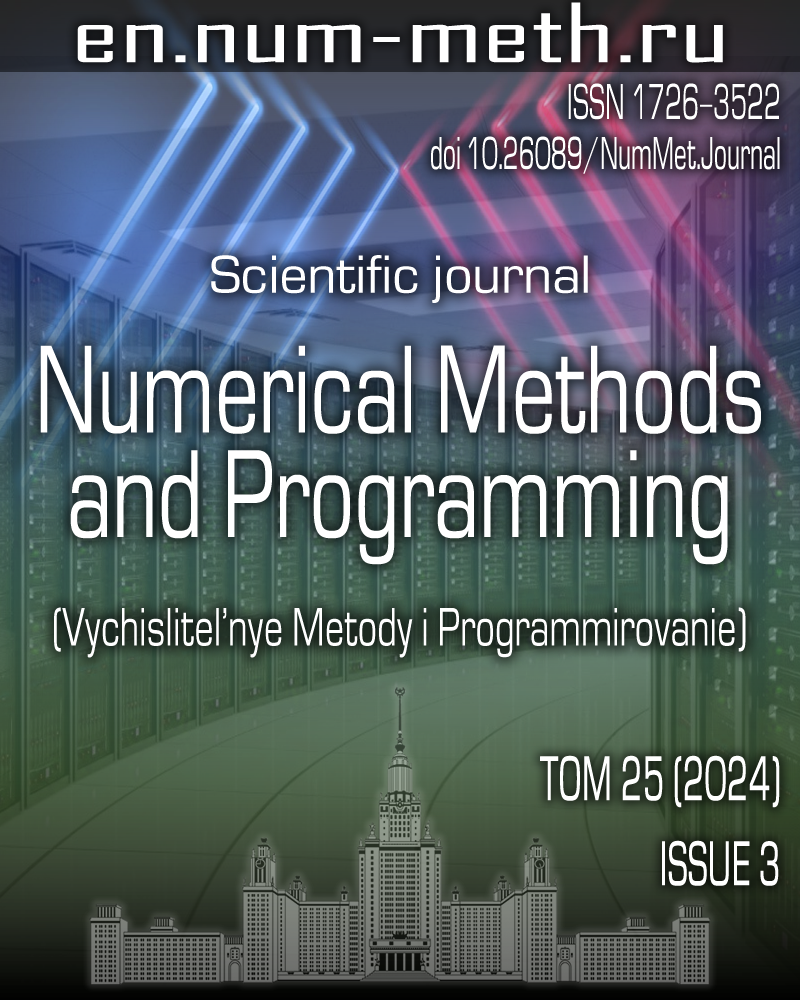DOI: https://doi.org/10.26089/NumMet.v25r321
An algorithm for approximating a discrete signal with a small number of harmonics with decreasing amplitudes
Keywords:
Abstract
An algorithm for approximating an arbitrary discrete signal by a trigonometric polynomial with decreasing harmonics in amplitude is proposed. It has an algorithmic complexity of O(NR(L + log2 N)), where L is the length of the polynomial, N is the length of the set of samples of the original signal, and NR is the length of the frequency basis of the fast Fourier transform (FFT) algorithm. The flowcharts of the developed algorithms, the source texts of Python programs, and the results of numerical experiments are presented. The developed algorithms can be applied to improve domestic technologies in the field of electronics and software, as well as included in the curricula of engineering specialties.
Published
Issue
Section
References
- A. B. Sergienko, Digital Signal Processing (Piter, St. Petersburg, 2002) [in Russian].
- D. D. Kosheleva and A. V. Doronina, “Fourier Transform and Fast Fourier Transform,” Innovatsii. Nauka. Obrazovanie. No. 38, 626-632 (2021).
- S. A. Bakhurin, “Time-Domain Decimation FFT Algorithm,”
https://ru.dsplib.org/content/fft_dec_in_time/fft_dec_in_time.html . Cited July 19, 2024. - S. P. Sikorskiy and E. V. Ivanchukov, “Digital Signal Processing and Fourier Transform in the Case of Spectral Spreading,” Zh. Nauchnykh i Prikladnykh Issledovaniy. 1 (11), 67-69 (2016).
- N. M. Popov and A. N. Serov, “Comparative Analysis of Methods for Reducing the ’Spectral Spreading’ Effect,” Avtomatizatsiya Izmereniya v Mashinostroyenii, No. 3, 48-53 (2019).
- E. V. Dmitriev, “Harmonic Discrete Spectra and Approximation of Short Processes, Signals, and Functions,” Aviakosmicheskoe Priborostroenie, No. 3, 23-31 (2006).
- E. V. Dmitriev, “Detection and Discrimination of Signals in Additive Mixture by Calculation and Analysis of Natural Spectrum,” Fizika Volnovykh Protsessov i Radiotekhnicheskie Sistemy. 11 (2), 61-66 (2008).
https://elibrary.ru/item.asp?id=12931786 . Cited July 19, 2024. - V. G. Getmanov, “On Reducing the Solution Time of the Discrete Trigonometric Approximation Problem,” Avtometriya, No. 6, 108-110 (1988).
- V. G. Getmanov, R. A. Dabagyan, and R. V. Sidorov, “Studying Geomagnetic Pulsation Characteristics with the Local Approximation Method,” Geomagnetism i Aeronomiya, 56 (2), 209-216 (2016) [Geomagn. Aeron. 56 (2), 195-202 (2016)].
doi 10.1134/S0016793216020055 - V. K. Abalakin, E. P. Aksyonov, E. A. Grebenikov, et al., Handbook of Celestial Mechanics and Astrodynamics (Nauka, Moscow, 1976) [in Russian].
- S. L. Marple, Digital Spectral Analysis with Applications (Prentice-Hall, Englewood Cliffs, 1987; Mir, Moscow, 1990).
- O. N. Granichin and D. V. Pavlenko, “Data Randomization and L_1-Optimization,” Komp’yuternye Instrumenty v Obrazovanii, No. 1, 4-13 (2010).
- B. A. Knyazev and V. M. Chernen’kiy, “Convolutional Sparse Coding for Static and Dynamic Images Analysis,” Nauka i Obrazovanie, No. 11, 664-695 (2014).
doi 10.7463/1114.0730860 - O. V. Osipov, “Iterative FFT-Algorithms with High Frequency Resolution,” Numerical Methods and Programming (Vychislitel’nye Metody i Programmirovanie). 22 (2), 123-137 (2021).
doi 10.26089/NumMet.v22r209 - A. A. Burtsev, “Optimization of Fast Fourier Transform Operation in OpenCL Environment,” Trudy Inst. Sistemnykh Issledovaniy RAN. 12 (1-2), 11-27 (2022).
doi 10.25682/NIISI.2022.1-2.0002 - V. G. Getmanov, Digital Processing of Signals (NIYAU MEPhI, Moscow, 2010).
- S. V. Porshnev and D. V. Kusaikin, “On Accuracy of Trigonometric Interpolation,” Digital Signal Processing (Tsifrovaya Obrabotka Signalov), No. 1, 43-51 (2019).
https://elibrary.ru/item.asp?id=41269684 . Cited July 19, 2024. - S. I. Ziatdinov and N. V. Girin, “Analysis of Errors in Trigonometric Interpolation,” Izv. Vyssh. Uchebn. Zaved., Priborostroen. 51 (5), 42-45 (2008).
- V. M. Efimov and A. L. Reznik, “Sampling Functions in Periodical Signal Reconstruction. The Variance of a Trigonometric Interpolation Error,” Avtometriya 41 (4), 3-14 (2005). [Optoelectron., Instrum. Data Process. 41 (4), 3-13 (2005)].
https://sibran.ru/en/journals/issue.php?ID=120300 . Cited July 20, 2024. - O. V. Osipov, “Spectral Analysis of Discrete Signals with High Frequency Resolution,” Numerical Methods and Programming (Vychislitel’nye Metody i Programmirovanie). 20 (3), 270-282 (2019).
doi 10.26089/NumMet.v20r324 - T. V. Vaseeva and E. A. Altman, “Algorithm for Finding the Optimum Unbias Estimate of the Amplitude Harmonics Based on the Method of Correlation Functions,” Vestn. Rostov Gos. Univ. Putey Soobshchen., No. 1, 168-176 (2022).
doi 10.46973/0201-727X_2022_1_168 - S. N. Chizhma and R. I. Gazizov, “Method of Spectral Analysis of Signals in Power Supply Systems,” Omskiy Nauch. Vestn., No. 1, 198-201 (2013).
License
Copyright (c) 2024 О. В. Осипов

This work is licensed under a Creative Commons Attribution 4.0 International License.


